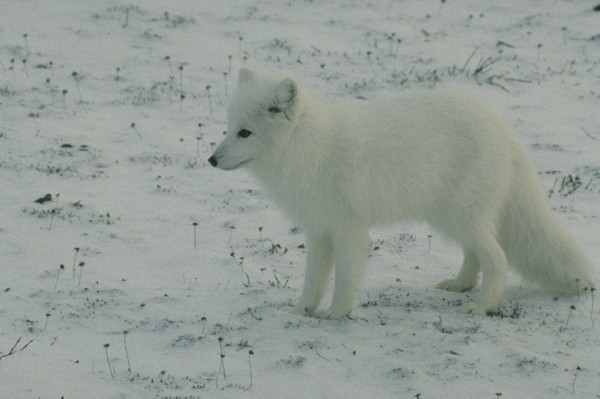Arctic Foxes, wolves and Wolverines
Arctic Foxes

From recent studies it has been seen that, "past and current industrial
activities on the North Slope have probably increased the availability of
shelter and food for the arctic fox" (4, pg. 117). Like
bears, these animals too use oil fields for foraging on garbage, or resting.
Foraging of these sites is more likely to occur in the winter when food is more
scare than in the summer. It has been observed that "foxes do not avoid human
activity" (4) raising their young in the proximity of traveled roads and
operating drill rigs. Over the years it is remarked that, "the density and the
rate of occupancy of dens and the sizes of litters are greater in oil fields
than in adjacent areas" (4). These increasing fox numbers have a
negative impact on bird population, which are extensively hunted by these. This
can be especially "devastating to colonial birds" or to birds that migrate
to the area (4). An increase number of roads, has also allowed foxes to access
other bird populations that were before inaccessible to them. Thus, it has been
seen that oil exploration in the Alaskan region increases fox population which
has an adverse effect on other species, such as birds.*
¡@
Wolves and Wolverines
 ¡@
¡@
Wolves primarily den in the foothills and mountains south of the coastal
plain in the refuge. Wolverines are infrequently observed but travel in all
types of arctic terrain, and females may use snowdrifts along small tundra
streams for dens. During spring, wolves roam out to the coastal tundra where
they prey on newborn caribou. Population declines or changes in distribution of
wolves are results PREDICTED from the increased mortality, decreased prey, harassment, and disturbance in denning areas caused by oil development. The
cumulative effects of displacement, avoidance, and reduced food resources could
result in long-term changes in wolverine distribution. (5)
The following article are directly quoted from the official website of ANWR:
http://www.r7.fws.gov/nwr/arctic/wolf.html
"Wolves have long been a lightning rod for controversy. They evoke
passionate feelings in many of us. Some people love them, a few fear them,
others prefer that they be shot. On the Arctic Refuge, however, these
differences are seldom voiced. Why? The wolf is wild, beautiful, and inspiring.
So is the Refuge. The two belong together. People know it and expect it.
Cousin to the dog, the gray wolf is a highly social animal, preferring to
live in packs. The pack, dominated by a male/female pair, may include their pups
of the year, wolves born the previous year, and other adults.
Gray wolves may be shades of gray, brown, black, or white. Wolves of all
these colors roam the Refuge. Some five packs totalling 25 to 30 animals live on
the Refuge's north slope east of the Canning River. The wolves are found
primarily in the mountains and foothills along major rivers.
The makeup of wolf packs on the Refuge's north slope varies. In summer, many
wolves hunt alone or in pairs. Some are "drifters." Others may switch
packs or move to new areas, perhaps following the caribou migration. In winter
the packs stay together more to hunt.
Gray wolves mate in late February and March. The pairs then move to maternity
dens near rivers in the foothills and mountains. About four to seven pups are
born in late May or early June. The pups are weaned during the summer, and the
dens are abandoned in July or August. By early winter, the pups can travel and
hunt with the adult wolves.
Although to date, no dens have been found on the Refuge coastal plain, wolves
make frequent trips there from May to July when the Porcupine caribou herd is
present. After the caribou leave the coastal plain, the wolves stay in the
mountains and foothills hunting caribou, along with Dall sheep and moose.
Wolves, however, are opportunistic feeders. They will catch small rodents,
birds, and ground squirrels if they can.
Natural relationships between predator and prey still prevail on the Arctic
Refuge. Here the wolf's connection to the caribou and the land continues as it
has for centuries. Untamed and free, the wolf is a symbol for the Refuge - a
truly remarkable place."
Works Cited
4. Environmental Assessment, Redouct Shoal Unit
Development Project, section 3.8.3 .
http://yosemite.epa.gov/R10/water.nsf/0/9316eb066fa30af088256b4b000a77e6/
$FILE/Forest%20Oil%20EA%20Section%2003A%20Affected%20(Baseline)%20Environment.pdf
5. Protection of the Artic National Wildlife Refuge: Key to Managing
one of the World's Most Biologically Valuable Ecoregions, the Arctic Coastal
Tundra" WWF (2000)

